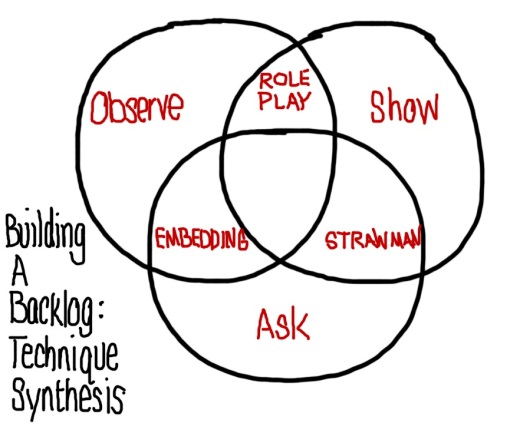Hand Drawn Chart Saturday
Techniques for building an initial backlog can be classified by how the conversation between stakeholders and the project team is initiated. Some techniques are focused on asking, other techniques focus on observing, while the third category is all about showing something and getting reactions. Most practitioners blend the best from each of the categories. Here are some examples of the hybrid techniques:
Role Playing Prototype: This technique blends paper prototypes (show) with role-playing (observe) to get users and stakeholders to consider how they might act in an environment that has not been fully designed.
Straw man/JAD: This synthesis seeds a JAD session (ask) with an loose outline of a solution or set of potential solutions that are used to guide the discussion which are at the core of JAD. However, the seeding tactic can inhibit creativity. The technique is less constraining when a set of competing solutions is used as the conversation seed, however developing the range of solutions before the JAD session increases the cost of the JAD.
Embedding: This techniques puts team member(s) into a department to actually perform the work (observe) alongside actual users and stakeholders. This generally requires the embedded team member to be trained and mentored to intimately see how the work is done. I have seen debrief sessions added to this technique to ensure that participants get a chance to discuss the nuances in the workflow. As I have noted before, with any observation technique everyone needs to understand what is going on and why. This is not an episode of Undercover Boss.
Combining tactics from different categories of techniques that teams use to develop an initial backlog can fundamentally change the dynamics of the requirements definition session. A group of stakeholders will generally have a diverse range of learning and interaction styles that they favor. Combining backlog building techniques gives the project team a better chance at making a connection. Combining techniques should not be done randomly or an ad-hoc basis. Selecting which techniques to combine has four prerequisites:
- Someone with experience and training (perhaps a business analyst).
- A knowledge of the user community (knowledge the product owner can provide).
- Planning (time and effort).
- Involved users and stakeholders (call on the product owner and project sponsor to help with this prerequisite).
Developing an initial backlog is a step to get projects going and moving in the right direction. It is, however, only a first step. Backlogs will evolve. Teams, product owners, users and other stakeholders will gain knowledge and experience as the project move forward that will continually shape and reshape the backlog.

December 29, 2014 at 11:56 pm
[…] project work items can be captured using standard techniques for building an initial backlog (observation, showing, asking and/or synthesis). Backlogs for most projects can be developed using these techniques. Many smaller items or grand […]
May 24, 2016 at 11:56 pm
[…] and maintaining the detailed backlogs, including: asking, observing, showing and all sorts of hybrids. Using the onion metaphor, the techniques we have explored in the past are the second layer of the […]